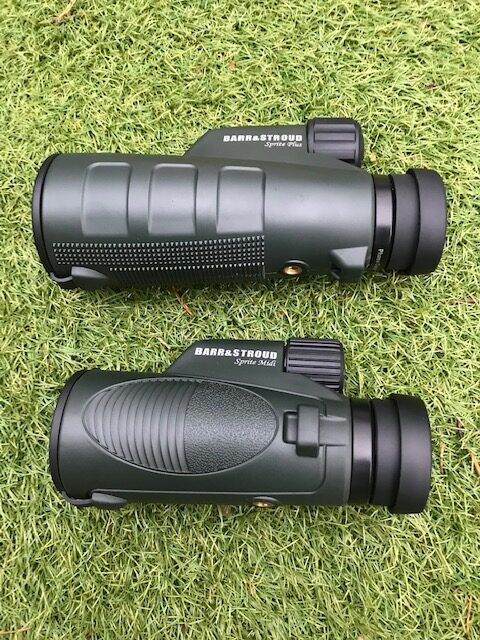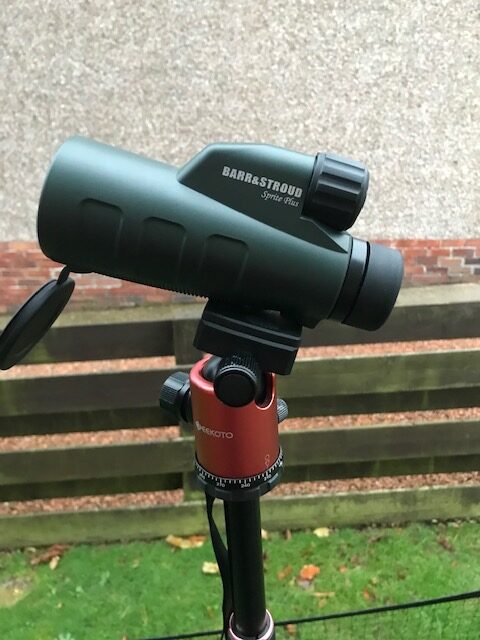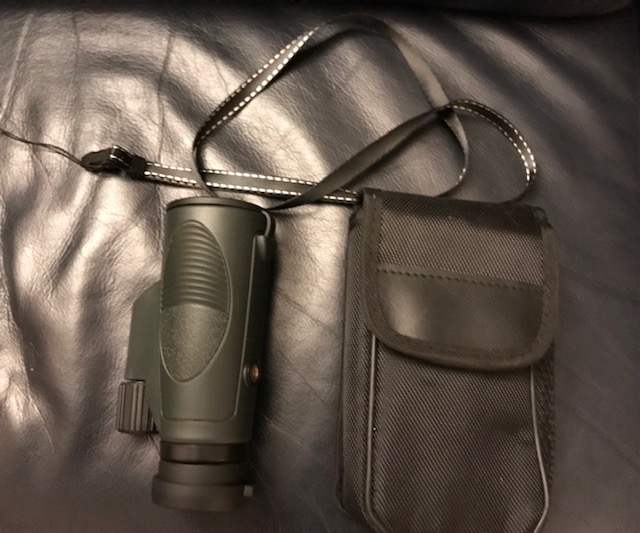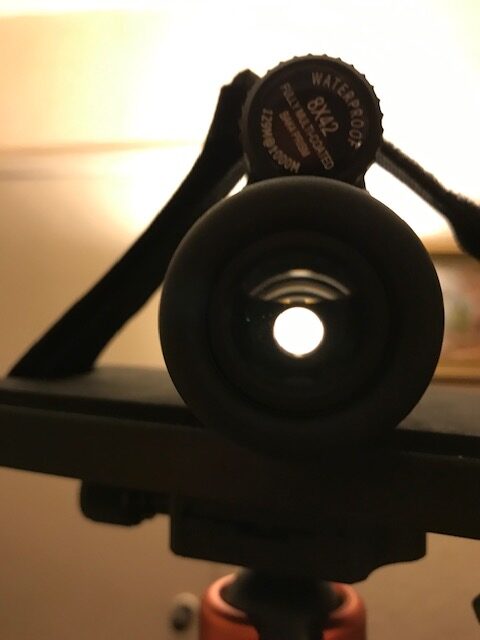
The Barr & Stroud Sprite Plus 15 x 50 (top) and Sprite Midi 8 x 42(bottom).
A Work Commenced December 10 2021
Product Names: Barr & Stroud Sprite Midi 8 x 42/ Plus 15 x 50
Country of Manufacture: China
Eye Relief: 5.25mm(8×42)/ 3.33mm(15×50)
Field of View: 129m@1000m(8 x 42)/ 66m@1000m(15 x 50)
Eye Relief: 17.5mm(8 x 42)/ 11mm(15 x 50)
Coatings: Fully Multicoated, silvered and phase corrected Bak4 prisms(8 x 42 Midi non phase coated)
Chassis Material: Rubber Armoured Polycarbonate
Waterproof: Yes (1.5m for 3 minutes)
Nitrogen Purged: Yes
Close Focus: 3m(8 x 42)/2.5m(15×50) advertised, 2.9 and 2.2 m measured, respectively
Tripod Mountable: Yes
Weight: 339g(8 x 42)/ 448g(15 x 50)
Dimensions: 139x80x55mm(8 x 42)/165X80X62mm(15 x 50)
Accessories: Soft padded carry case, lens cleaning cloth, carry strap, warranty card & instruction sheet, tethered rubber objective and ocular caps
Warranty: 10 Years
Retail Price(UK): £59.95(8x 42)/ £74.95(15 x 50)
In several previous reviews, I’ve showcased a few binoculars made by Barr & Stroud. As I explained before, I cut my first binocular teeth with a modern roof prism binocular by Barr & Stroud just over three years ago, and have always been impressed by their excellent bang for buck. Unlike so many other instruments in the same price range, which showed mis-collimated barrels, too much field curvature, chromatic aberration and sub-standard ergonomics, Barr & Stroud products punched well above their weight in terms both of the quality of the optics they presented and the rugged no-nonsense chassis in which those optics were housed. In this review, I’ll be discussing the optical and ergonomic features of two nifty monoculars from the same company; the Sprite Midi 8 x 42, and the higher power Sprite Plus 15 x 50. But before we get to those details, let’s take some time to go over the reasons why a monocular might suit an individual more than a binocular.
A monocular is, quite simply, half a binocular. Thus, it uses one eye rather than two. Some people have natural deficiencies in one eye, such as severe astigmatism for example, that results in their inability to properly adjust the dioptre setting on a regular binocular leading to a blurred image. Others have one eye damaged in some way and so can’t avail of the natural advantages of using both eyes. Some folk like to use monoculars because they are smaller and lighter than the equivalent binocular and this may prove to be very important if space and weight constraints are very tight. Monoculars are now available in many sizes and magnifications. Low power monoculars have magnification ranges similar to that found in modern compact and full-sized binoculars, but higher powered units function more like mini-spotting scopes, enabling the user to lock in on small targets beyond the range of binoculars or seeing details quite invisible to conventional, hand-held binoculars. Yet another advantage of a monocular is cost; it’s just cheaper to use a monocular than a binocular of the same aperture.
What does one lose in going from a binocular to a monocular? Well, a few things actually. Depth perception for one thing, as our eyes were designed in such a way that they both create the sensation of focus depth, allowing us to gain a sense of the 3-dimensional shape of objects and how far away they are. Many observers enjoy up to a 40 per cent gain in contrast using binoculars compared with the same sized monocular. The reasons for this are not entirely understood but suffice it to say that using two eyes increases the signal to noise ratio in the electrical impulses that are created in viewing an object. Many observers also report that monoculars are harder to hold steady than binoculars of the same aperture. Despite these drawbacks, most of the main binocular manufacturers also produce monoculars, and Barr & Stroud is no exception.
First Impressions & Ergonomics
Both the Barr & Stroud monoculars have a polycarbonate chassis overlaid by a grippy, green rubber armouring. The polycarbonate body cuts down on weight and is perfectly adequate for most observing schedules. Both instruments fit very easily in the palm of your hand. They are both very lightweight; the 8 x 42mm weighing at 350g and the 15 x 50mm just 100g more. In this capacity, both the Sprite Midi 8x 42 and Plus are no heavier than the average compact binocular. Both instruments come with a rubberised rain guard and a tethered objective cover, which means you’ll never lose it in the field.

Both Barr & Stroud Monoculars have a permanently tethered objective cover.
In a previous blog, I commented on my great fondness for the quality of the focusers on a number of Barr & Stroud binoculars. And these binoculars are no exception. Both instruments have silky smooth focus wheels, which are large and easy to negotiate with just one finger. They do however have slightly different textures; I found that I preferred the less expensive Midi Sprite focus wheel over the larger 15 x 50 Sprite Plus. It was just slightly easier to grip and engage with throughout its travel.

The focus wheel on both Barr & Stroud monoculars are of high quality but I liked the extra grip afforded by the less expensive Midi model.
Both monoculars are equipped with pull-up eyecups that lock rigidly in place. The smaller 8 x 42 Sprite Midi has very generous eye relief. I was easily able to observe the full field with my eye glasses on. The larger Sprite Plus however, has considerably less eye relief, but if push came to shove, I was just able to engage with the full field but it was certainly challenging!

Both monoculars have well made twist up eyecups that lock rigidly in place.
Both Barr & Stroud monoculars come with a screw thread which enables you to mate it to a tripod or monopod for extra visual stability.

Both monoculars can be easily mated to a tripod or monopod.
Both monoculars come with a padded case and a carry strap that you can easily affix to the instrument.

Each monocular is supplied with a padded carry case and strap to carry it from place to place.
Optics
Both Barr & Stroud monoculars feature fully multicoated optics and BaK4 Schmidt Pechan roof prisms. The less expansive Sprite Midi 8x 42 is not phase coated however, unlike the higher power 15 x 50 Sprite Plus. The Sprite Midi 8 x 42 appears to have the same specifications as the 8 x 42 Sahara binocular with a field of view of 129m@1000m or 7.35 angular degrees but has a noticeably longer close focus at 2.59m(as opposed to just 1.98m for the Sahara binocular). Intriguingly, the Sprite Plus 15 x 50 monocular has a significantly better close focus of just 2.2 metres, which is also considerably less than the 2.5m advertised.

The higher power Spite Plus 15 x 50 has phase coated roof prisms unlike the smaller Sprite Midi.
Looking at the exit pupil of both monoculars showed a significantly better result for the larger Sprite Plus 15 x 50. Although both presented with nice round pupils, the 8 x 42 Midi had more stray light close to the pupil, as the images below show.

The exit pupil presented in the Sprite Midi 8 x 42.

The exit pupil presented by the Sprite Plus 15 x 50.
These results were also somewhat reproduced in my tests for internal reflections, by directing a bright beam of my IPhone 7 torch into the monoculars from across a room and inspecting the images visually. The Midi 8 x 42 did show significantly more internal reflections and diffused light around the beam than the larger 15 x 50 Plus unit. That said, these stray light artefacts were not terribly injurious to the image and both gave passable results when directed at a sodium street light after dark, and also on a bright Moon.
The daylight images served up by the 8 x 42 Midi monocular are bright and sharp. Contrast is good and chromatic aberration is very well controlled, with only the outer part of the field showing a trace. The 8 x 42 has a large sweet spot covering perhaps 60 per cent of the field but beyond that astigmatism and pincushion distortion increase gradually towards the field stop. I was also able to confirm these findings under the stars.
I judged the larger Sprite Plus 15 x 50 to be better optically than the smaller 8 x 42. Despite its higher power, the images it served up had higher contrast than the latter, a consequence I suppose of its phase corrected roof prisms. The field of view was flatter and better corrected in the 15 x 50 too. Star testing showed that most of its 3.78 degree true field was very well corrected, with only the outer 15 per cent showing significant distortion. Chromatic aberration was more conspicuous but never to an unacceptable degree. High contrast objects against a bright over cast sky background does show some but that’s just par for the course and most folk can easily ignore it and just get on with observing.
I found the 15 x 50 unit more versatile than the 8 x 42. With its substantial magnification, I enjoyed employing it as a mini spotting scope, either mounted on a monopod or simply by finding a suitable branch or fence post to rest it on. If you’re observing from a car, a small beanbag also works wonders stabilising the view. The 15x is just right for bridging the gap between a standard binocular view and a larger spotting scope. For example, I was able to make out nice, high-resolution details on a Grey Heron that were quite invisible in 8x and 10x binoculars. The 15 x 50 is a nifty instrument for studying the phases of the Moon; all the way from slender crescent to full on full Moon. Crater fields and maria show up sharply and in very high contrast; a true refractor image. The Plus proved to be a rather good, low-power, rich field telescope too, delivering up very impressive views of larger deep sky objects such as the Pleiades, the Beehive Cluster, the Andromeda Galaxy and the Double Cluster. Views of the Sword Handle of Orion also proved very compelling through the Spite Plus.
In addition to its higher magnification, the better close focus on the Sprite Plus 15 x 50 made it a rather good, long distance microscope, affording crystal clear views of leaf litter, bark, rock formations, fungi and tree branches. Indeed, if coupled to a digi-scoping adapter, it works well as an ultraportable telephoto lens.
In summary, both the Sprite Midi 8 x 42 and Plus 15 x 50 represent excellent value for money. They are well made, small, lightweight, easy to use, weather resistant and serve up very decent optics for their modest price tags. If your outdoor activities are in need of a magnification boost, give one of these monoculars a try. You won’t be left second guessing!
Neil English is the author of seven books on amateur and professional astronomy, including Choosing and Using a Refracting Telescope.
Another good review, Neil. I might just go for the 15×50!
Thank you Mark,
Much appreciated. They sure are handy little devices with good optics and build quality.
With best wishes,
Neil.
Hi, Neil.. Just purchased /received the 15×50 mono. Did you have trouble twisting the eyecup? Mine won’t budge?!!!! I don’t want to force it too much, in case it breaks!!! Thanks. Regards. Mark
Hi Mark,
Yeah my one doesn’t twist up either. I don’t mind it though, it still works fine. I’m OK with that.
Best wishes,
Neil.
I think a lot of people { as you mentioned } can’t hold a monocular steady, is because they just use one hand.
I always hold a monocular the same way as I hold binoculars, with both hands, and I keep both eyes open, this is very important.
My none observing eye focuses on the back of either my left or right hand, depending on which eye I use.
I’ve never seen an advert of anyone using a monocular the way it should be held.
The Sprite Plus 15×50 is getting my attention.
Thank you.
Hello Steve,
Monoculars are cool. The 15 x 50 is very good for getting quick close up views if you happen to be out with a regular 8x glass and want to zoom in on something interesting. It’s a great way to get extra power without sacrificing much in the way of portability as it can fit in any pocket. Good tip on holding the monocular too.
Cheers,
Neil.